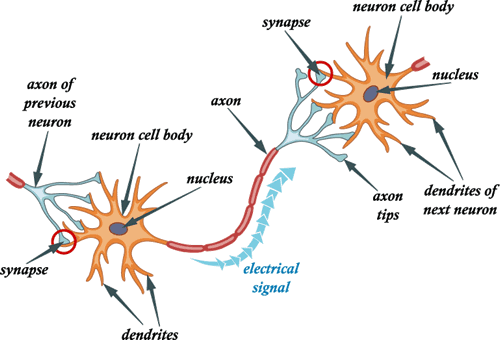General Biology II, lecture on Neurobiology
XIII. Neural Structure
A. Neuron (Single Unit - Consists of:)
1. Dendrite(s)
a. beginning
i. where signal comes into neuron
ii. usually short
2. Cell Body (Soma)
a. contains nucleus, ER, golgi, etc
i. site of neurotransmitter production
3. Axon
a. takes message or signal where its going
i. often very long
b. Bouton
i. widening of axonal ending
1) facilitates transmission of signal
ii. 1st 1/2 of synapse
1) presynaptic
4. Synapse (to clasp): 3 parts
a. presynaptic side (1st part) connects to
i. other neurons
1) postsynaptic side (2nd part)
2) with astrocytes
a) side boundaries (3rd part)
b) tripartite synapse
ii. other cells (e.g. muscles)
b. site of delivery of neural signal
i. electrically
ii. chemically - neurotransmitters
B. Nerve(s)
1. collection of neuronal axons
C. Ganglia / Nuclei
1. collection of neural cell bodies
a. ganglion - in the Peripheral NS
i. bulbous
b. nucleus - in the Central (Brain & Spinal cord) NS
XIV. Neural Function
A. Neural Transmission (propagation, signal, depolarization, impulse,
conduction, action potential)
1. Direction
a. begins at dendrite
b. travels (mostly) along axon
c. moves from neuron to neuron (or to other cells) by synapses
i. ensheathed by astrocyte network
2. Mechanism
a. ion balance
i. Na+/K+ ATPase = active transport
ii. Na+ pumped out,
therefore [Na+] higher outside the neuron
iii. K+ pumped in, [K+] higher in
iv. some K+ leaks out (pores)
(1) + charge greater outside the cell
(2) - charge greater inside the cell
(a) large proteins with a negative
charge inside the cell
b. signal transmission
i. actual electricity - resting potential = -70mV
ii. perturbation to cell membrane
(1) Na+ rushes in K+ out
along [Na+] / [Na+] gradients
(a) Na+ first, K+ slightly later
(2) depolarization
(3) + / - charges move along electrical gradient
(4) this movement of depolarization is the
action potential
(5) Na+ rushes in as each new section of
axon becomes depolarized
(a) depolarization (a perturbation) opens the
gates to Na+ (= Na+ channels)
(b) new Na+ rushing in reinforces
the depolarization/action potential
(6) this is normal movement,
as when the signal begins at the dendrite
iii. K+ rushes out, then Active transport
begins moving Na+ and K+ again
(1) restores resting potential
(2) repolarization
iv. depolarization spike
1) measuring potential
as signal moves along the axon
2) Na+ moving in lowers the negative
potential (depolarization), then makes it positive
3) K+ rushing out (slightly later) restores
negative potential,
a) then overshoots -70mV (hyperpolarizes)
4) Na+/K+ ATPase / repolarization
returns the cell to the resting potential
c. Saltatory propagation
i. Oligodendrocytes & Schwann cells
1) Glial cells associated with neurons
2) includes myelin
a) wrapped around axons
b) fat
ii. Node of Ranvier
1) between Schwann cells
iii. increased membrane resistance
1) less time moving ions across the membrane
2) current moves along its gradient more quickly
3) depolarization reinforced at the node
d. at the synapse
i. neurotransmitters waiting in golgi vesicles
e.g.
1) dopamine (DA), NE, Epi, acetylcholine (ACh),
serotonin (5-HT), GABA, glutamate (Glu) ...
ii. when the signal reaches the Bouton
neurotransmitter released by exocytosis
iii. transmitter travels across synaptic cleft to receptors
1) Astrocytes help keep tranmitter
in the synapse
2) Astrocytes facilitate the signal
a) Astrocytes can signal too
iv. binding to receptors begins signal on next cell
v. enzymes degrade transmitters in cleft,
or transmitter is taken back up by the original cell
and astrocytes to be reused
e. electric synapses
i. Bouton membranes so closely apposed that gap junction
channels allow the electrical signal to
continue down the membrane of the new cell
3. Excitatory and Inhibitory Synapses
a. the effect of neurotransmitters may be stimulatory
i. causing a new action potential in the following neuron
or stimulating a non-neural cell
ii. neuromodulation
(1) may enhance the probability of
another neuron having an action potential
b. but it may be inhibitory:
i. inhibiting an action potential in another cell
c. neurons may have excitatory and inhibtory neurons
impinging upon them

